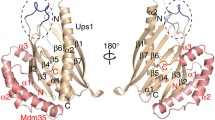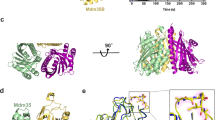Abstract
The F0 membrane domain of F0F1-ATPase complex had been purified from porcine heart mitochondria. SDS-PAGE with silver staining indicated that the purity of F0 was about 85% and the sample contained no subunits of F1-ATPase. The purified F0 was reconstituted into liposomes with different phospholipid composition, and the effect of CL (cardiolipin), PA (phosphatidic acid), PI (phosphatidylinositol) and PS (phosphatidylserine) on the H+ translocation activity of F0 was investigated. The results demonstrated that CL, PA and PI could promote the proton translocation of F0 with the order of CLPA>PI, while PS inhibited it. Meanwhile ADM (adriamycin) severely impaired the proton translocation activity of F0 vesicles containing CL, which suggested that CL’s stimulation of the activity of reconstituted F0 might correlate with its non-bilayer propensity. After F0 was incorporated into the liposomes containing PE (phosphatidylethanolamine), DOPE (dioleoylphosphatidylethanolamine) as well as DEPE (dielaidoylphosphatidylethanolamine), it was found that the proton translocation activity of F0 vesicles increased with the increasing content of PE or DOPE, which has high propensity of forming non-bilayer structure, but was independent of DEPE. The dynamic quenching of the intrinsic fluorescence of tryptophan by HB (hypocrellin B) as well as fluorescent spectrum of acrylodan labeling F0 at cysteine indicated that CL could induce F0 to a suitable conformation resulting in higher proton translocation activity.
Similar content being viewed by others
References
Daum, G., Lipids of mitochondria, Biochim. Biophys. Acta, 1985, 822: 1.
Cullis, P. R., De Kruijff, B., Lipid polymorphism and the functional roles of lipids in biological membranes, Biochim. Biophys. Acta, 1979, 559: 399.
Li, L., Zheng, L. X., Yang, F. Y., Effect of propensity of hexagonal II phase formation on the activity of mitochondrial ubiquinol-cytochrome c reductase and H+-ATPase, Chem. Phys. Lipids, 1995, 76: 135.
Yang, F. Y., Huang, F., Effect of non-bilayer lipids on the activity of membrane enzymes, Chem. Phys. Lipids, 1996, 81: 197.
Yue Jiachang, Li Shengguang, Zhu Xiongwei, Conformational change of F0 moiety during uni-site ATP hydrolysis of H+-ATPase, Acta of Biophysica Sinica (in Chinese), 1996, 12: 585.
Lutter, R., Abrahams, J. P., Van Raaij, M. J. et al., Crystallization of F1-ATPase from bovine heart mitochondria, J. Mol. Biol., 1993, 229: 787.
Beechey, R. B., Hubbard, S. A., Linnett, P. E. et al., A simple and rapid method for the preparation of adenosine triphosphatase from submitochondrial particles, Biochem. J., 1975, 148: 533.
McEnery, M. W., Buhle, E. L. Jr., Aebi, U. et al., Proton ATPase of rat liver mitochondria, Preparation and visualization of a functional complex using the novel zwitterionic detergent 3-[(3-cholamidopropyl) dimethylammonio]-1-propanesulfonate, J. Biol. Chem., 1984, 259: 4642.
McEnery, M. W., Hullihen, J., Pedersen, P. L., F0 “Proton channel” of rat liver mitochondria, J. Biol. Chem., 1989, 264: 12029.
Prendergast, F. G., Meyer, M., Carlson, G. L. et al., Synthesis, spectral properties, and use of 6-acryloyl-2-dimethylaminonaphthalene (Acrylodan), A thiol-selective, polarity-sensitive fluorescent probe, J. Biol. Chem., 1983, 258: 7541.
Simpson, I. A., Sonne, O., A simple, rapid, and sensitive method for measuring protein concentration in subcellular membrane fractions prepared by sucrose density ultracentrifugation, Anal. Biochem., 1982, 119: 424.
Collinson, I. R., Runswick, M. J., Buchanan, S. K. et al., F0 Membrane domain of ATP synthase from bovine heart mitochondria: Purification, subunit composition and reconstitution with F1-ATPase, Biochemistry, 1994, 33: 7971.
Goormaghtigh, E., Chatelain, P., Caspers, J. et al., Evidence of a specific complex between adriamycin and negatively-charged phospholipids, Biochim. Biophys. Acta, 1980, 597: 1.
Goormaghtigh, E., Vandenbranden, M., Ruysschaert, J. M. et al., Adriamycin inhibits the formation of non-bilayer lipid structures in cardiolipin-containing model membranes, Biochim. Biophys. Acta, 1982, 685: 137.
Walker, J. E., Lutter, R., Dupuis, A. et al., Identification of the subunits of F1F0-ATPase from bovine heart mitochondria, Biochemistry, 1991, 30: 5369.
Author information
Authors and Affiliations
Corresponding author
Rights and permissions
About this article
Cite this article
Yang, H., Huang, Y., Zhang, X. et al. Cardiolipin is essential for higher proton translocation activity of reconstituted F0 . Sci. China Ser. C.-Life Sci. 44, 146–155 (2001). https://doi.org/10.1007/BF02879319
Received:
Issue Date:
DOI: https://doi.org/10.1007/BF02879319




